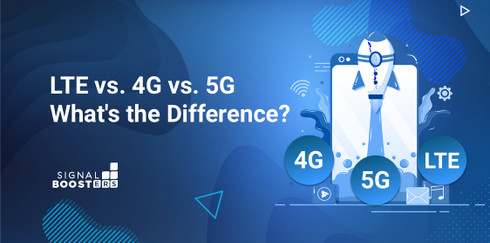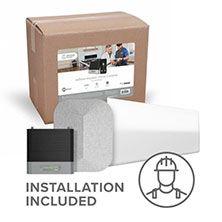Cellular LTE vs. 4G vs. 5G: What is the Difference?

4G vs LTE vs 5G... what are those symbols on our phones, and what do they mean? Is 4G better than LTE, and is 5G better than both? Is 4G and LTE the same? Which does a cell phone signal booster boost? Let’s look at the difference between the three terms and find out what this means for your cell signal.
Take advantage of our system design and installation services. Learn more or call us for a free consultation: 1-800-969-8189.
What is 4G?
Networks are classified into generations based on speed, connectivity and reliability standards. This is set by the by the International Telecommunications Union-Radio communications sector (ITU-R). 4G stands for the 4th Generation of telephone service. We’ve been through 2G, 3G, are currently in 4G and 5G. 4G Standards were developed in 2008 and they have completely replaced 3G. 4G is the general standard now, although within a few years we can expect most of the world to be on 5G. Despite the newer technology becoming the norm, we can be sure that but 4G isn’t going anywhere for a while.
A 4G or 4G LTE phone takes advantage of this generation’s standards. Many 4G phones today are 5G enabled, but will still make use of 4G if the network is stronger or 5G is not available. If you are worried about your signal strength, investing in a signal booster is your best bet.
Bolton Technical Victory Yagi/Panel Kit
- Best for small to midsize homes
- Boosts talk, text, and 4G/5G data
- Up to 4,000 sq ft coverage
- Up to +72 dB gain, with 26 dBm uplink
- Includes highest quality cellular antennas and cables
The Bolton Technical Victory Yagi/Panel is the most powerful multi-carrier cellular booster in its class. It features up to 72 dB gain and incredible uplink power, ensuring a significant signal boost throughout your home or office. Under best conditions, it can blanket up to 4,000 sq ft with strong, reliable reception. Equipped with the highest quality cellular antennas and cables, it delivers the strongest possible cell signal for multiple devices.
This particular kit dominates in areas with weak outside signal. For those with decent outside cell reception, consider the Victory Omni/Panel.
Cel-Fi GO X Smart Signal Booster Kit
- Indoor cellular coverage up to 15,000 sq. ft.
- EXPECTED INDOOR COVERAGE:
- 5,000 sq. ft. with 1-2 bars(-100 dB) of outside signal
- 10,000 sq. ft. with 3-4 bars (-90 dB) of outside signal
- 15,000 sq. ft. with 5 bars of outside signal
- The industry’s most powerful signal booster
- Get 100 dB gain for any cellular carrier
- Boosts talk/text/data for Verizon, AT&T, and T-Mobile
- Exclusive antenna options for even better coverage
Make your house your home. Ensure you have the best cellular coverage with a Cel-Fi GO-X cell phone signal booster.
The Cel-Fi GO-X is the most advanced carrier-specific signal booster in the world, greatly enhancing 5G, 4G and 3G cell service for all your wireless devices (smartphones, notebooks, hotspots, etc.) for any single carrier - including Verizon, AT&T, T-Mobile, and US Cellular. Provides coverage up to 15,000 sq. ft. in any building.
weBoost Installed Home Complete Cell Phone Signal Booster Kit
- Enhances cellular coverage up to 7,500 sq. ft.
- FREE professional installation
- Works for all phones & all US carriers
- Our most powerful home unit
- Nationwide next-day to three day installation upon receipt
The weBoost Installed Home Complete mobile signal booster is useful for people who rely on their cell phones for their home offices. If you require a stronger cellular signal to stay in contact with customers, vendors, remote employees, your employer, and everyone else in your life, the weBoost Home Complete cell phone signal amplifier can help. It covers up to 7,500 sq ft under best conditions. Real-world results put it around 4,000-6,000 sq ft. Of course, depending on your outside signal strength and outside antenna mounting choice, you may get more or less coverage.
What is LTE?
LTE is actually a neat little trick that helps the consumer recognize 4G. It stands for Long Term Evolution and usually shows up on your screen as 4G LTE. It was a standard developed in the early stages of 4G to enable phones and towers to talk to each other. There were other standards developed at the same time called UMB (Ultra Mobile Broadband) and WiMax. LTE won out as the global standard technology for cellular communications. It is an open, interoperable standard used by virtually all carriers. All major smartphones use LTE today.
The sneaky thing about LTE is that it actually represents the step before true 4G. True 4G is defined by speeds over 100Mbps. When LTE was developed, few networks or phones could actually achieve this, hence 4G LTE was launched.
LTE provided high speed mobile and broadband data, telephone service, and supported public safety functions. Although it is much faster than the previous generation of 3G, it is still below the 100Mbps speeds requited of true 4G. LTE also has special features to manage the network such as the public safety network having their own frequency on the LTE spectrum. It can assign priorities to customers. Emergency calls get a higher priority for calls than someone like you or me. If there are many folks on the network, the priorities will decide which call gets through first and which one might get dropped. One other feature of LTE is that it is a self-organizing network, meaning that if there is an outage, the calls will be rerouted to another path automatically and once service is restored, the network will revert back to its designed path.
For an even more detailed explanation, click here.
What is 4G LTE-A?
LTE-A, LTE-Advanced and LTE+ are all names for the same service. It is the advanced or upgraded version of LTE, which is faster, more stable, and has higher bandwidth availability than regular LTE. These days phones and networks are quite capable of maintaining speeds of over 100mps. This network is actually true 4G, although because of a marketing trick is called LTE+. Many consumers still believe that 4G LTE is superior to plain 4G, and want to see LTE at the top of their phones. To keep everyone happy, carriers have named their 4G networks as a version of LTE.
LTE+ has less buffering and faster downloads than regular 4G LTE. Data rates are higher with peak download speed of 3 Gbps and Uploads at 1.5 Gbps. That is 2-3 times faster than regular LTE speeds.
The network can use what is called carrier aggregation. This combines up to 5 signals that let data pass through antennas at the some time. Different carriers can then combine the bandwidth signal and provide faster speeds. There is also a technology called MIMO which means multi-input and multi-output. This means the signal can be transmitted and received through multiple antennas. Together these two technologies provide between traffic management of bandwidth. Thanks to this you get to enjoy more reliability and faster speeds. Coverage is increased via relay nodes as well, which fills in gaps in the network.
For a more detailed explanation, click here.
What is 5Ge vs 4G?
5Ge is AT&T's name for 4G LTE-A. In other words, it's just 4G, and there's nothing "5G" about it. If you see you're getting 5Ge service on your AT&T phone, that means you're getting LTE-Advanced service.
How Does 5G Compare to 4G
As with everything, the march of progress continues. Every ten years or so, the ITU-R comes out with new standards and new technology, and 5G or 5th Generation is the latest. 5G has been rolled out in most places around the country, although it is much more accessible in urban areas. You may find the outside of city limits your phone still says 4G. As we mentioned the 4G network will be around for quite a while and will fill in the coverage gaps where 5G is not available.
5G offers exponentially higher speeds than 4G and infinite possibilities. We will be able use of all sorts of exciting things like smarter appliances, self-driving cars, remote surgery and complex online games. To qualify as 5G, a network has to offer 1 Gbps with 1 millisecond of latency. Currently 5G is powerful, but doesn't travel very far. Cell towers have to be close together and devices have to be within range to receive signal. To work around this, 5G C- Band will be rolled out soon. It is also important to note that 5G nationwide will include 4G LTE coverage.
How Does 5G C-Band Work?
5G currently works on the millimeter-wave spectrum which is 24–47 GHz, and low-band spectrum which is 600 MHz–1 GHz. This means that it can either transfer data really fast, but with a very weak signal, or have stronger signal but is not very fast. The sweet spot between these two spectrums is called C-Band. C-Band has been around for a while, but traditionally has been used by satellite TV. It offers faster speeds and stronger signal than traditional 5G, is a way better network than 4G or LTE. The infrastructure for C-Band is already in place, it's just a matter of time before carriers switch it on.
What Does This All Mean?
For the next few years, 4G and LTE aren't going anywhere. Many IoT and M2M devices rely on the 4G network. LTE+ or LTE-A will be the norm for rural areas where 5G isn't available, and where that can't be found you will still get LTE. 3G has been completely phased out, so if you have cell signal it will be one of those three.
So, LTE is the standard just below actual 4G. LTE-A is 4G marketed to people who feel that LTE is better. 5G is better than both of those, and C-band will be better than regular 5G. In the meantime, it is always an option to have LTE and add a cell phone signal booster to enhance speeds.
Contact Us
We’re here to assist with any issues you might be experiencing with poor cell service. Contact us today, or call us at 1-800-470-6777.
Interested in Learning More? Check Out Our Cellular Info Hub / WiFi Info Hub








